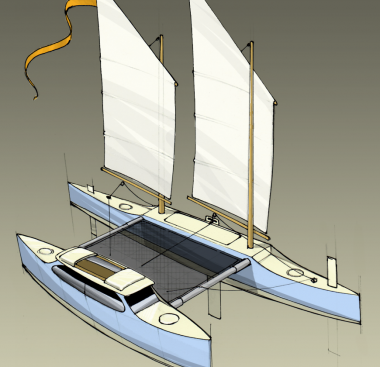Samwise - there and back again
Samwise is a minimalist cruising proa, which is really the only kind of proa there should be, IMHO. The only thing not minimal is the performance - the proa’s raison d’etre. The basic idea is reliable and cozy camp cruising in the Pacific NW - where the water is generally frigid and the air is generally tolerable.
Sam’s godfathers include Matt Layden’s Paradox and Rob Denney’s Harry, while a host of uncles include Phil Bolger, Peter Spronk, Dick Newick and Ralph Munroe. He (all proas are masculine) features simple plywood construction, an enclosed sailing cockpit, plenty of deck space, endless conversations at the dock, and the ability to go there and back again.
The crew helms from an enclosed sailing cabin - which is a nice feature in the Pacific NW and its nearly iceberg laden waters. Laugh at the freezing spray as you drive like an arrow to windward! Mock the waves as they surge impotently against your plexiglass shielding! Unlike tacking craft, proa crew have no need to make the treacherous trek to the other side with every tack. You are always on the good side of a proa.
In the unlikely event of pleasant sailing weather, you can slide open the hatches, or sit atop the flat cabin top, or even sprawl out on the trampoline, catching the sun. The tramp will also make a fine place to pitch a tent for overnighting - if a real double berth is required.
The leeward hull is the load bearer, so it stretches out to 24’ of lean, wake-cutting form. The windward hull is the ballast, which makes do with 18’ of LWL. Skilled sailors will fly the windward hull at every opportunity. Being flat-bottomed in sharpie style, the hope is that it will plane if given half the chance.
The free-standing schooner rig makes for a criminally low center of effort, while the standing lugs create a powerful yet balanced, easily handled sail that requires no purchase on the sheets - which comes in handy during a shunt. The forward lug is rigged with the mast to windward (its most aerodynamically advantageous position) while the aft lug is set opposite, which moves the combined CE well forward (a desirable thing on a proa).
Leeway is prevented by a central, pivoting leeboard mounted on the leeward hull, and steerage is provided by fore and aft “dagger” rudders. The hope is that in the unfortunate event of a grounding, the deep leeboard will hit first, pivoting gently out of harms way as it stops the boat, whilst leaving the delicate rudder intact. As usual with proa designs, the rudders are sketchy… at best. From model testing, I found a schooner rigged proa such as this will balance and self-steer on most courses by sail trim alone - Sam, by nature, is a virtuous course keeper. Be that as it may, a real cruising boat needs a real rudder. Suggestions are welcome.
The proa’s beam is retracted to trailer width via telescoping aluminum beams (as an option, Jim Shanahan has proposed an ingenious hinging mechanism).
Note: This sketch is a cartoon only. No plans are available.


